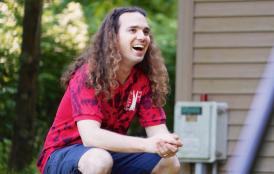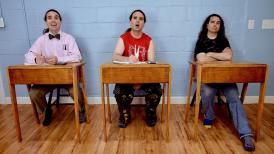Physics meets Filmmaking
Jonathan Thomas-Palmer started recording and editing videos of himself teaching during his time as a graduate student in the SecMAC program—now, his Flipping Physics YouTube channel has over 10 million views.
There was only one computer in the School of Education Building that had the video editing software Final Cut Pro in 2000. Jonathan Thomas-Palmer (AB ’97, AM ’00) used that computer to teach himself video editing as part of a year-long project every student in the Master’s of Arts with Secondary Teacher Certification (SecMAC) program had to complete before graduation.
“I thought it was a silly assignment at the time,” Thomas-Palmer said. Every student was tasked with learning something new in addition to completing full-time coursework and a teaching internship. Despite his initial skepticism, the video he edited of him teaching secured him his first job after graduation. Today, his passion for teaching and video help people all over the world learn physics.
After 10 years in the classroom, Thomas-Palmer decided to record his teaching again to see the progress he had made. Like many veteran teachers, he kept a copy of his lectures in a large binder and soon decided to record every single one. “I did not appreciate how much time it would take,” he said. But with 10 million views, 77 thousand subscribers, 500 videos and counting, Thomas-Palmer’s Flipping Physics YouTube channel is certainly appreciated by students and educators worldwide.
Thomas-Palmer also continues to teach part-time at Community High School in Ann Arbor. “The combination of the two is really good for me because Flipping Physics feeds me creatively and allows my teaching to reach beyond the walls of my classroom, which I love. I love hearing from people all over the planet about how I'm helping them learn physics, which is just really cool,” Thomas-Palmer said.
There are also a number of resources on the Flipping Physics website for educators interested in flipping their classroom. “It's funny because I started filming my classes first and then found out about flipping, and I was just like, this is a better way to do it,” he said. “It occurred to me that I've been teaching for, at this point, 12 years or something. And I was still teaching the way that I had been taught. And so much has changed in the last century of education that we need to... we can do this better.”
Thomas-Palmer initially struggled with transitioning to a flipped classroom, but he found it gave students a greater sense of ownership over their learning. Now, he hopes other educators embrace the challenge as well.
“One of the things that you need to learn as a human is that we fail. And we learn from the failure and we move on. Failure is learning, especially in science. People have this idea that you just understand everything. And it doesn't work that way. How science is done is we have an idea and it doesn't work, and so we change the idea and still doesn't work, and then eventually we come to one good idea that works. But it's only because we had 100 that didn't before it.”

